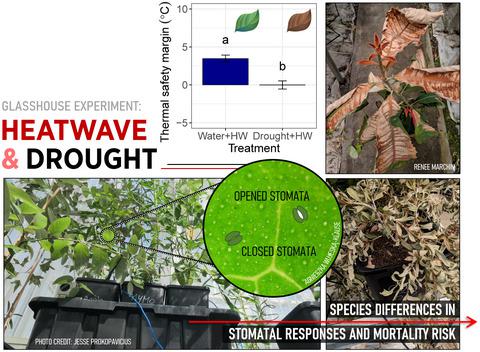当前位置:
X-MOL 学术
›
Glob. Change Biol.
›
论文详情
Our official English website, www.x-mol.net, welcomes your feedback! (Note: you will need to create a separate account there.)
Extreme heat increases stomatal conductance and drought-induced mortality risk in vulnerable plant species
Global Change Biology ( IF 11.6 ) Pub Date : 2021-11-06 , DOI: 10.1111/gcb.15976 Renée M Marchin 1 , Diana Backes 1 , Alessandro Ossola 2 , Michelle R Leishman 2 , Mark G Tjoelker 1 , David S Ellsworth 1
Global Change Biology ( IF 11.6 ) Pub Date : 2021-11-06 , DOI: 10.1111/gcb.15976 Renée M Marchin 1 , Diana Backes 1 , Alessandro Ossola 2 , Michelle R Leishman 2 , Mark G Tjoelker 1 , David S Ellsworth 1
Affiliation

|
Tree mortality during global-change-type drought is usually attributed to xylem dysfunction, but as climate change increases the frequency of extreme heat events, it is necessary to better understand the interactive role of heat stress. We hypothesized that some drought-stressed plants paradoxically open stomata in heatwaves to prevent leaves from critically overheating. We experimentally imposed heat (>40°C) and drought stress onto 20 broadleaf evergreen tree/shrub species in a glasshouse study. Most well-watered plants avoided lethal overheating, but drought exacerbated thermal damage during heatwaves. Thermal safety margins (TSM) quantifying the difference between leaf surface temperature and leaf critical temperature, where photosynthesis is disrupted, identified species vulnerability to heatwaves. Several mechanisms contributed to high heat tolerance and avoidance of damaging leaf temperatures—small leaf size, low leaf osmotic potential, high leaf mass per area (i.e., thick, dense leaves), high transpirational capacity, and access to water. Water-stressed plants had smaller TSM, greater crown dieback, and a fundamentally different stomatal heatwave response relative to well-watered plants. On average, well-watered plants closed stomata and decreased stomatal conductance (gs) during the heatwave, but droughted plants did not. Plant species with low gs, either due to isohydric stomatal behavior under water deficit or inherently low transpirational capacity, opened stomata and increased gs under high temperatures. The current paradigm maintains that stomata close before hydraulic thresholds are surpassed, but our results suggest that isohydric species may dramatically increase gs (over sixfold increases) even past their leaf turgor loss point. By actively increasing water loss at high temperatures, plants can be driven toward mortality thresholds more rapidly than has been previously recognized. The inclusion of TSM and responses to heat stress could improve our ability to predict the vulnerability of different tree species to future droughts.
中文翻译:

极端高温增加了脆弱植物物种的气孔导度和干旱引起的死亡风险
全球变化型干旱期间的树木死亡通常归因于木质部功能障碍,但随着气候变化增加了极端高温事件的频率,有必要更好地了解热应激的交互作用。我们假设一些受干旱胁迫的植物在热浪中自相矛盾地打开气孔,以防止叶子严重过热。我们在温室研究中对 20 种阔叶常绿乔木/灌木物种进行了实验性加热(>40°C)和干旱胁迫。大多数水分充足的植物避免了致命的过热,但干旱加剧了热浪期间的热损伤。热安全裕度 (TSM) 量化了叶片表面温度和叶片临界温度之间的差异,其中光合作用被破坏,确定了物种对热浪的脆弱性。有几种机制有助于高耐热性和避免破坏性叶片温度——小叶尺寸、低叶渗透势、高单位面积叶质量(即厚、致密的叶)、高蒸腾能力和水的获取。与水分充足的植物相比,水分胁迫的植物具有更小的 TSM、更大的树冠枯死和完全不同的气孔热浪响应。平均而言,浇水充足的植物会关闭气孔并降低气孔导度(g s ) 在热浪期间,但干旱的植物没有。具有低g s 的植物物种,无论是由于缺水情况下的等水气孔行为还是固有的低蒸腾能力,都会在高温下打开气孔并增加g s 。目前的范式认为气孔在超过水力阈值之前关闭,但我们的结果表明等水物种可能会显着增加g s(超过六倍增加)甚至超过了它们的叶膨胀损失点。通过在高温下积极增加水分流失,植物可以比以前认识到的更快地达到死亡率阈值。包含 TSM 和对热应激的反应可以提高我们预测不同树种对未来干旱的脆弱性的能力。
更新日期:2022-01-05
中文翻译:

极端高温增加了脆弱植物物种的气孔导度和干旱引起的死亡风险
全球变化型干旱期间的树木死亡通常归因于木质部功能障碍,但随着气候变化增加了极端高温事件的频率,有必要更好地了解热应激的交互作用。我们假设一些受干旱胁迫的植物在热浪中自相矛盾地打开气孔,以防止叶子严重过热。我们在温室研究中对 20 种阔叶常绿乔木/灌木物种进行了实验性加热(>40°C)和干旱胁迫。大多数水分充足的植物避免了致命的过热,但干旱加剧了热浪期间的热损伤。热安全裕度 (TSM) 量化了叶片表面温度和叶片临界温度之间的差异,其中光合作用被破坏,确定了物种对热浪的脆弱性。有几种机制有助于高耐热性和避免破坏性叶片温度——小叶尺寸、低叶渗透势、高单位面积叶质量(即厚、致密的叶)、高蒸腾能力和水的获取。与水分充足的植物相比,水分胁迫的植物具有更小的 TSM、更大的树冠枯死和完全不同的气孔热浪响应。平均而言,浇水充足的植物会关闭气孔并降低气孔导度(g s ) 在热浪期间,但干旱的植物没有。具有低g s 的植物物种,无论是由于缺水情况下的等水气孔行为还是固有的低蒸腾能力,都会在高温下打开气孔并增加g s 。目前的范式认为气孔在超过水力阈值之前关闭,但我们的结果表明等水物种可能会显着增加g s(超过六倍增加)甚至超过了它们的叶膨胀损失点。通过在高温下积极增加水分流失,植物可以比以前认识到的更快地达到死亡率阈值。包含 TSM 和对热应激的反应可以提高我们预测不同树种对未来干旱的脆弱性的能力。



























 京公网安备 11010802027423号
京公网安备 11010802027423号